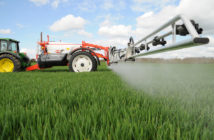With T2 sprays complete for many, and only late drilled crops left to go, what have we learned from this season so far?
Iain Hamilton, Syngenta senior field technical manager, explains that the dry weather, which has dominated this season, has brought its own challenges.
“March and April have been unseasonably dry for the majority of the country, with the Met Office stating that the UK as a whole, has seen just 41% of the average April rainfall.
“As a result of this, we’ve seen crops suffer under the drought-like conditions, but this hasn’t necessarily resulted in low disease pressure, as many assumed it would do. A key message that’s been paramount this season has been not to cut back on rates just because it’s dry.
“Powdery mildew has been a big issue this year across the country, which has been attributed to the drought stress many crops have succumbed to. Septoria has been visible at the base of crops waiting to rear its head, and the dry conditions have not halted the development of yellow rust.”
Mr Hamilton explains that with leaves four and five infected with Septoria, there is a risk of the disease moving up to top leaf layers. “Any rainfall we see going forward may therefore mean that the yield-bearing leaves could be severely infected. Hence, it’s been important to get T2 sprays on at the right time to protect crops.
“In addition to this, we’re also hearing reports that fully emerged flag leaves are a lot shorter in some areas than you would expect, an issue that is not necessarily related to variety, and has been a much talked about subject among agronomists.
“This could mean that leaf two and even leaf three may become more significant this year in their contribution to yield. All the more reason to ensure a robust fungicide programme is in place,” says Mr Hamilton.
“The myth that dry conditions result in low disease pressure has well and truly been disproved this year. We can’t predict what’s around the corner, and therefore, even in average disease pressure years, there is still a vital role for SDHI fungicides that can deliver powerful and consistent disease control.
“Although crops may not reach initial yield targets this year, it’s worth protecting what you have. There is still potential in crops.
“This is the first-year growers have used Syngenta’s new SDHI fungicide, ELATUSTM ERA. We will see the true results of its performance as we head into harvest. But, from the hundreds of field trials undertaken during its discovery journey, we’re confident in its ability to deliver, despite the difficult conditions,” he says.
“This season has been a challenge, but there is plenty for us all to learn from going forward.”




